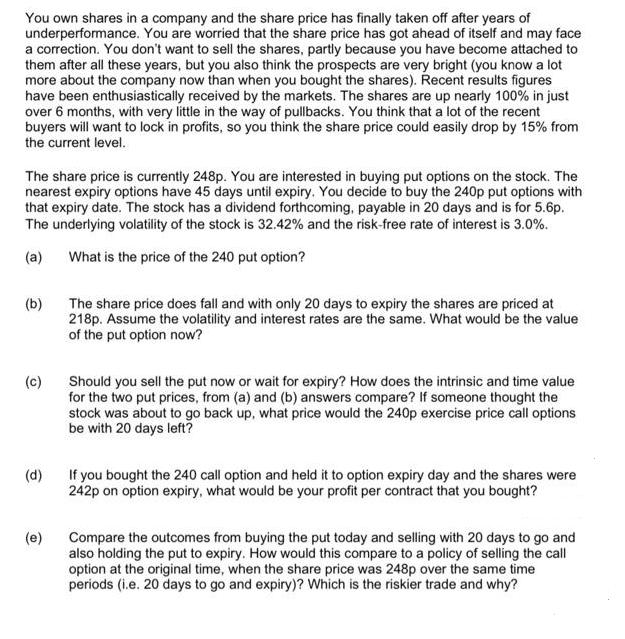Answered step by step
Verified Expert Solution
Question
1 Approved Answer
You own shares in a company and the share price has finally taken off after years of underperformance. You are worried that the share

You own shares in a company and the share price has finally taken off after years of underperformance. You are worried that the share price has got ahead of itself and may face a correction. You don't want to sell the shares, partly because you have become attached to them after all these years, but you also think the prospects are very bright (you know a lot more about the company now than when you bought the shares). Recent results figures have been enthusiastically received by the markets. The shares are up nearly 100% in just over 6 months, with very little in the way of pullbacks. You think that a lot of the recent buyers will want to lock in profits, so you think the share price could easily drop by 15% from the current level. The share price is currently 248p. You are interested in buying put options on the stock. The nearest expiry options have 45 days until expiry. You decide to buy the 240p put options with that expiry date. The stock has a dividend forthcoming, payable in 20 days and is for 5.6p. The underlying volatility of the stock is 32.42% and the risk-free rate of interest is 3.0%. (a) What is the price of the 240 put option? (b) (c) (d) (e) The share price does fall and with only 20 days to expiry the shares are priced at 218p. Assume the volatility and interest rates are the same. What would be the value of the put option now? Should you sell the put now or wait for expiry? How does the intrinsic and time value for the two put prices, from (a) and (b) answers compare? If someone thought the stock was about to go back up, what price would the 240p exercise price call options be with 20 days left? If you bought the 240 call option and held it to option expiry day and the shares were 242p on option expiry, what would be your profit per contract that you bought? Compare the outcomes from buying the put today and selling with 20 days to go and also holding the put to expiry. How would this compare to a policy of selling the call option at the original time, when the share price was 248p over the same time periods (i.e. 20 days to go and expiry)? Which is the riskier trade and why?
Step by Step Solution
★★★★★
3.40 Rating (159 Votes )
There are 3 Steps involved in it
Step: 1
ANSWER a The price of the 240 put option would be 1047p b The value of the put option would now be 2...
Get Instant Access to Expert-Tailored Solutions
See step-by-step solutions with expert insights and AI powered tools for academic success
Step: 2

Step: 3

Ace Your Homework with AI
Get the answers you need in no time with our AI-driven, step-by-step assistance
Get Started


